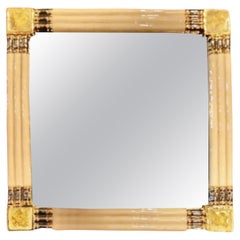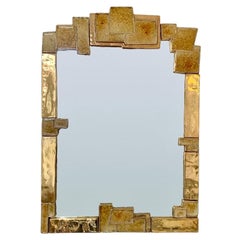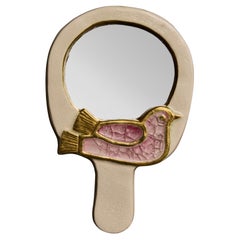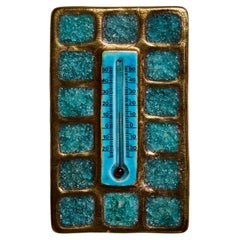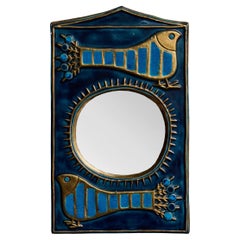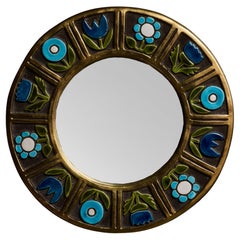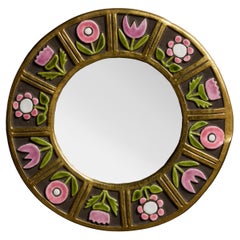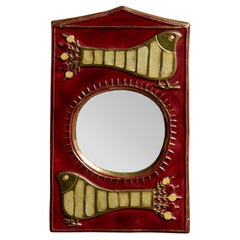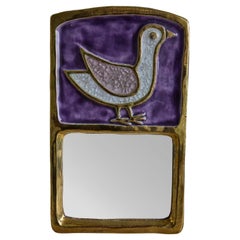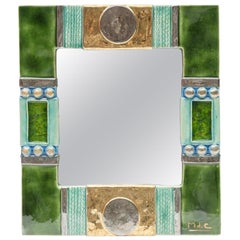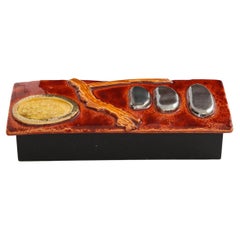Marion De Crecy
Vintage 1970s Wall Mirrors
Ceramic, Glass
Late 20th Century French Mid-Century Modern Sunburst Mirrors
Ceramic, Mirror
1990s French Mid-Century Modern Wall Mirrors
Ceramic
Vintage 1960s French Mid-Century Modern Wall Mirrors
Ceramic, Mirror
Vintage 1960s French Mid-Century Modern Scientific Instruments
Ceramic
Vintage 1960s French Mid-Century Modern Scientific Instruments
Ceramic
Vintage 1960s French Mid-Century Modern Wall Mirrors
Ceramic
Vintage 1960s French Mid-Century Modern Wall Mirrors
Ceramic, Mirror
Vintage 1960s French Mid-Century Modern Wall Mirrors
Metal
Vintage 1960s French Mid-Century Modern Wall Mirrors
Ceramic
Vintage 1960s French Mid-Century Modern Wall Mirrors
Ceramic
Vintage 1960s French Mid-Century Modern Wall Mirrors
Ceramic, Glass, Mirror
Vintage 1960s French Mid-Century Modern Wall Mirrors
Ceramic
Vintage 1960s French Mid-Century Modern Scientific Instruments
Ceramic
Vintage 1960s French Mid-Century Modern Decorative Boxes
Ceramic
Vintage 1960s French Mid-Century Modern Scientific Instruments
Ceramic
Recent Sales
Early 2000s French Wall Mirrors
Ceramic
20th Century French Modern Decorative Boxes
Ceramic
Vintage 1970s French Mid-Century Modern Wall Mirrors
Ceramic
Vintage 1970s French Modern Decorative Boxes
Ceramic, Wood
Vintage 1960s French Mid-Century Modern Wall-mounted Sculptures
Ceramic
Vintage 1970s French Mid-Century Modern Scientific Instruments
Ceramic
Vintage 1960s French Mid-Century Modern Decorative Dishes and Vide-Poche
Ceramic
Vintage 1950s French Mid-Century Modern Wall Mirrors
Enamel
Vintage 1960s French Mid-Century Modern Decorative Boxes
Ceramic
Vintage 1960s French Mid-Century Modern Wall Mirrors
Ceramic
Vintage 1960s French Mid-Century Modern Wall Mirrors
Ceramic, Mirror
Vintage 1960s French Mid-Century Modern Wall Mirrors
Ceramic
Vintage 1960s French Mid-Century Modern Scientific Instruments
Ceramic
Vintage 1960s French Mid-Century Modern Wall Mirrors
Ceramic, Mirror
Vintage 1970s French Mid-Century Modern Decorative Boxes
Ceramic, Glass, Wood
Vintage 1960s French Mid-Century Modern Wall Mirrors
Ceramic
Vintage 1960s French Mid-Century Modern Table Mirrors
Ceramic, Mirror
Vintage 1960s French Mid-Century Modern Decorative Boxes
Ceramic, Wood
Mid-20th Century French Wall Mirrors
Ceramic, Mirror, Wood
People Also Browsed
Antique Mid-19th Century English High Victorian Taxidermy
Other
2010s South African Minimalist Pedestals
Hardwood
2010s British Scandinavian Modern Ottomans and Poufs
Velvet, Mohair, Oak
21st Century and Contemporary Mexican Mid-Century Modern Table Lamps
Fiberglass, Linen, Fabric, Wood
Vintage 1950s Italian Mid-Century Modern Console Tables
Beech
Vintage 1940s Swedish Art Deco Vases
Ceramic
21st Century and Contemporary Italian Mid-Century Modern Chandeliers and...
Brass
21st Century and Contemporary Colombian Mid-Century Modern Wall Lights a...
Brass
2010s German Organic Modern Wall Mirrors
Mirror, Oak
20th Century French Brutalist Sunburst Mirrors
Iron, Gold Leaf, Wrought Iron
21st Century and Contemporary Indian Modern Side Tables
Pyrite, Nickel
2010s American Modern Chandeliers and Pendants
Brass
2010s Italian Modern Table Lamps
Brass
21st Century and Contemporary Italian Mid-Century Modern Chandeliers and...
Metal
20th Century Danish Scandinavian Modern Chandeliers and Pendants
Copper, Steel
Vintage 1950s French Modern Abstract Sculptures
Ceramic
Marion De Crecy For Sale on 1stDibs
How Much is a Marion De Crecy?
Mithé Espelt for sale on 1stDibs
Marie-Thérèse Espelt, known better as Mithé Espelt, was a dominant force in mid-20th-century ceramics in France. Mithé is remembered for her modern ceramic wall mirrors, gilded and enameled ashtrays and other ornate objects and boxes, often featuring birds and lively colors. She preferred not to sign her pieces and, as a consequence, much of her work has been misattributed, including to French ceramist François Lembo.
Mithé grew up in the Camargue region of France. Her father’s extensive network included 1904 Nobel Prize winner Frédéric Mistral and Parisian painter and decorator Jean Hugo. Mithé’s early introduction to a community of artists inspired her to study sculpture and drawing at the Beaux-Arts School in Montpellier in 1939.
Mithé’s early work caught the attention of French ceramist Emilie Decanis and jewelry distributor Charles Démery. Mithé set up a ceramics workshop in the Hôtel de Bernis in Lunel, where she quickly garnered a reputation for her ceramic work and accessories, including mirrors, jewelry boxes and buttons. Démery founded the Souleiado boutique, which began distributing Mithé’s work, thus attracting a worldwide audience.
French author Antoine Candau wrote a retrospective book on Mithé’s career titled Mithé Espelt, the Discreet Luxury of the Every Day, which contributed to bringing her legacy to the forefront while shedding light on her anonymity. While Mithé was respected within her inner circle, the general public is only now beginning to understand the immense talent behind her over five-decade-long career.
Find Mithé Espelt mirrors, decorative objects, wall decorations and more for sale on 1stDibs.
A Close Look at Mid-century Modern Furniture
Organically shaped, clean-lined and elegantly simple are three terms that well describe vintage mid-century modern furniture. The style, which emerged primarily in the years following World War II, is characterized by pieces that were conceived and made in an energetic, optimistic spirit by creators who believed that good design was an essential part of good living.
ORIGINS OF MID-CENTURY MODERN FURNITURE DESIGN
- Emerged during the mid-20th century
- Informed by European modernism, Bauhaus, International style, Scandinavian modernism and Frank Lloyd Wright’s architecture
- A heyday of innovation in postwar America
- Experimentation with new ideas, new materials and new forms flourished in Scandinavia, Italy, the former Czechoslovakia and elsewhere in Europe
CHARACTERISTICS OF MID-CENTURY MODERN FURNITURE DESIGN
- Simplicity, organic forms, clean lines
- A blend of neutral and bold Pop art colors
- Use of natural and man-made materials — alluring woods such as teak, rosewood and oak; steel, fiberglass and molded plywood
- Light-filled spaces with colorful upholstery
- Glass walls and an emphasis on the outdoors
- Promotion of functionality
MID-CENTURY MODERN FURNITURE DESIGNERS TO KNOW
- Charles and Ray Eames
- Eero Saarinen
- Milo Baughman
- Florence Knoll
- Harry Bertoia
- Isamu Noguchi
- George Nelson
- Danish modernists Hans Wegner and Arne Jacobsen, whose emphasis on natural materials and craftsmanship influenced American designers and vice versa
ICONIC MID-CENTURY MODERN FURNITURE DESIGNS
- Eames lounge chair
- Nelson daybed
- Florence Knoll sofa
- Egg chair
- Womb chair
- Noguchi coffee table
- Barcelona chair
VINTAGE MID-CENTURY MODERN FURNITURE ON 1STDIBS
The mid-century modern era saw leagues of postwar American architects and designers animated by new ideas and new technology. The lean, functionalist International-style architecture of Le Corbusier and Bauhaus eminences Ludwig Mies van der Rohe and Walter Gropius had been promoted in the United States during the 1930s by Philip Johnson and others. New building techniques, such as “post-and-beam” construction, allowed the International-style schemes to be realized on a small scale in open-plan houses with long walls of glass.
Materials developed for wartime use became available for domestic goods and were incorporated into mid-century modern furniture designs. Charles and Ray Eames and Eero Saarinen, who had experimented extensively with molded plywood, eagerly embraced fiberglass for pieces such as the La Chaise and the Womb chair, respectively.
Architect, writer and designer George Nelson created with his team shades for the Bubble lamp using a new translucent polymer skin and, as design director at Herman Miller, recruited the Eameses, Alexander Girard and others for projects at the legendary Michigan furniture manufacturer.
Harry Bertoia and Isamu Noguchi devised chairs and tables built of wire mesh and wire struts. Materials were repurposed too: The Danish-born designer Jens Risom created a line of chairs using surplus parachute straps for webbed seats and backrests.
The Risom lounge chair was among the first pieces of furniture commissioned and produced by celebrated manufacturer Knoll, a chief influencer in the rise of modern design in the United States, thanks to the work of Florence Knoll, the pioneering architect and designer who made the firm a leader in its field. The seating that Knoll created for office spaces — as well as pieces designed by Florence initially for commercial clients — soon became desirable for the home.
As the demand for casual, uncluttered furnishings grew, more mid-century furniture designers caught the spirit.
Classically oriented creators such as Edward Wormley, house designer for Dunbar Inc., offered such pieces as the sinuous Listen to Me chaise; the British expatriate T.H. Robsjohn-Gibbings switched gears, creating items such as the tiered, biomorphic Mesa table. There were Young Turks such as Paul McCobb, who designed holistic groups of sleek, blond wood furniture, and Milo Baughman, who espoused a West Coast aesthetic in minimalist teak dining tables and lushly upholstered chairs and sofas with angular steel frames.
Generations turn over, and mid-century modern remains arguably the most popular style going. As the collection of vintage mid-century modern chairs, dressers, coffee tables and other furniture for the living room, dining room, bedroom and elsewhere on 1stDibs demonstrates, this period saw one of the most delightful and dramatic flowerings of creativity in design history.
